Right on time at 14:00 on 2 February 2024, we were able to welcome a group of 18 interested railway enthusiasts to the St. Johanns-Tor in Basel for the tour of Basel.
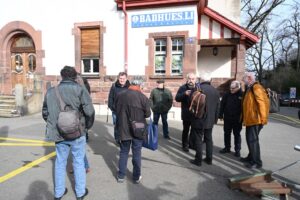
Our guide Thomas Hofmeier took us on an exciting trip back in time. At St Johann’s Gate, he drew our attention to inconsistencies in an entertaining way. For example, the guide grooves in the side walls don’t match the portcullis above our heads. The reason is simple: although the original trapdoor could be closed very quickly, it was unfortunately very heavy and unwieldy to open. As it was never used for military purposes, it was decided to replace it with individual bars. This made it much more flexible to open only parts and thus, for example, only allow passenger traffic. Ultimately, the gates were used for everyday access and customs control.
He entertained us with amusing details: when there were times of war, the guns and associated ammunition were checked in advance, always with the result that bullets and gunpowder were missing. What had happened? Citizens were obliged to keep night watch on a rotational basis. It was boring, which was made more bearable with wine as a distraction. Bullets could be used to weigh down nets, for games or as raw material for the forge. And gunpowder had to be bought for the obligatory exercises, so bullets and gunpowder travelled from the town gate to a private dwelling in one or two bags filled at night.
 |
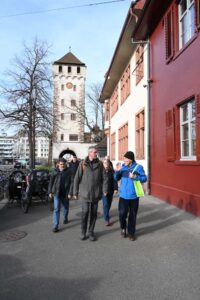 |
What does this have to do with railway stations? When the first railways appeared, the city walls and city gates had largely lost their military function. However, they were very important for the customs control of goods and the monitoring of people entering and leaving the city. In 1844, the last war with France (Napoleon) had not been long ago. For this reason, the authorities did not want goods and people from Alsace to be allowed to enter Basel unchecked. After lengthy discussions, it was decided to offer the private railway company a free space in front of the existing city walls and to move them. When the station was built, a new city gate was constructed through which two tracks ran and the city wall was rebuilt 800 metres around the station area! The gate was accessible from above like a bridge, which became a major attraction for the people of Basel. The Alsace railway station, which opened in 1844, was the first railway station on Swiss soil and trains ran here around two years before the official first train in Switzerland, the Spanisch Brötli Bahn.
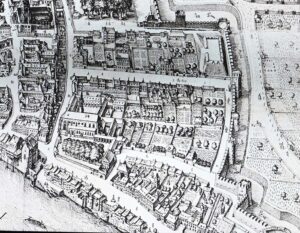 |
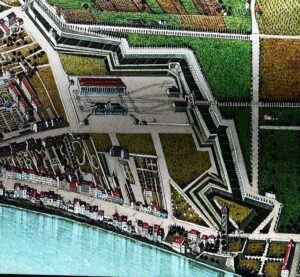 |

What led to the great success of the railways?
Around 1850, the roads were in an extremely poor condition and barely passable. They were only used when there was no other option. The transport of goods from the Mediterranean to Holland, for example, could be carried out almost continuously on rivers and canals, which was around 50 times cheaper than transport by road. It was only necessary to use the road for 20 kilometres on this route.
However, shipping was not without danger and was unreliable. The Rhine was not yet canalised and had no locks. There were rapids and sandbanks. After every flood, the course of the river changed and new routes had to be found. At low water, shipping traffic was cancelled. With the railway, a reliable, all-weather and cost-effective means of mass transport was now available for the first time.
However, the Alsace railway station was not in operation for very long. The first wooden building burnt down after a year and the subsequent stone building only served its purpose until 1860, when the tracks of the Central Railway arrived in Basel from the south and the decision was made to build a new central station.
The new city gate and the newly built city walls did not last long either. Only 15 years after its construction, in 1859, it was decided to demolish all the city gates and raze the walls and use the space gained as a park or for roads. This was not realised 100%, so that we can still admire 3 city gates in Basel today as witnesses of the old days.
After visiting the site of the Alsace railway station, we travelled by tram to the Historical Museum to look at the city maps and pictures shown above. The Basel tram company shortened our waiting time with the Dante Schuggi, the Ce 4/4 450.
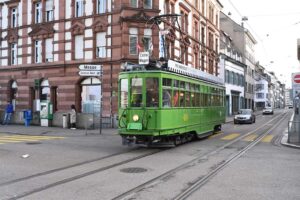
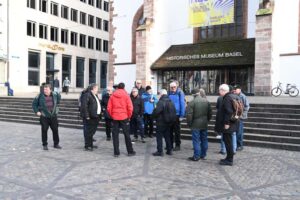
Finally, we took the tram to Basel’s main railway station. From Bahnhofplatz, it looks like a terminus station, which was the usual form of railway station in cities at the time. However, in Basel the two railway lines came from exactly 180 degrees apart. Only with large loops would it have been possible to realise the parallel entry into a terminus station. It was therefore decided to place the railway stations with the tracks to the side of the terminus building, which also made sense as they were built several years later. This arrangement was a stroke of luck, as “cross-border” track connections could be added without great effort.
Incidentally, the location and orientation of the station is no coincidence: the demolished city walls once stood there…
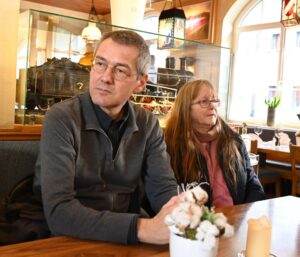 |
The successful excursion came to an end with a beer in a nearby pub under a model of a B3/4. Many thanks to our great guide Thomas Hofmeier and of course to our interested participants. 02.02.2024 Photo: Edi Meier, Bülach |
Back to: